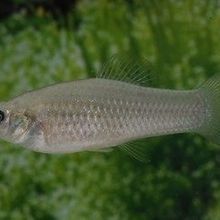Login
Subscribeecology, evolution

Black and Gray Wolf Pairings Stem Disease, Stabilize Population: Study
Katherine Irving | Oct 20, 2022 | 4 min read
The black fur allele has fitness costs but also confers higher immunity against canine distemper virus, making mix-and-match mating key to population survival.

For Frogs, Bigger Brains Mean Worse Camouflage
Natalia Mesa, PhD | Aug 23, 2022 | 3 min read
Frogs invest in cognitive capacity to avoid predators—up until there are too many hungry snakes around for the evolutionary strategy to pay off.

Dozens of Genes Tied to Caribou’s Seasonal Migration
Maddie Bender | May 2, 2022 | 2 min read
Researchers tracked the movements of endangered caribou and sequenced a portion of their genomes to determine which genes may influence migratory behavior.

Evolutionary Ecologist Matthew Gage Dies at 55
Amanda Heidt | Apr 20, 2022 | 3 min read
The University of East Anglia researcher was best known for his contributions to the study of sexual selection, particularly post-copulatory sperm competition.

Fruit Bats Echolocate During the Day Despite Having Great Vision
Natalia Mesa, PhD | Apr 20, 2022 | 4 min read
Contrary to what researchers had assumed, Egyptian fruit bats don’t rely solely on sight to orient themselves as they drink and forage for food in daylight.

Why Are Some Beetles Shiny? It’s Not What Researchers Thought
Connor Lynch | Mar 1, 2022 | 4 min read
The glossy shell of some beetles, it has long been speculated, helps hide the insects from predators. A recent paper put the hypothesis to the test—and found it wanting.

Q&A: How to Keep Antarctica Safe from Invasive Species
Dan Robitzski | Nov 23, 2021 | 8 min read
The Scientist spoke with University of Wollongong ecologist Dana Bergstrom about protecting the continent’s native plants and animals in the face of climate change and a growing human presence.

A Protist Hosts Both Green Algae and Purple Bacteria Symbionts
Abby Olena, PhD | Jun 11, 2021 | 3 min read
Having two different endosymbionts may allow the ciliate Pseudoblepharisma tenue to live in both oxygen-rich and oxygen-poor zones of the muddy bogs of southern Germany.

Specialized Leaves Keep This Plant’s Fruit Warm
Shawna Williams | Feb 1, 2021 | 4 min read
A volunteer nature guide teamed up with researchers to discover a unique reproductive role for one vine’s leaves.

Risk of Extinction Is Greatest for Large Herbivores: Study
Ruth Williams | Aug 5, 2020 | 3 min read
Data on vertebrate species that have become, or are likely to become, extinct reveal plant eaters are most under threat.

How Squirrels Use Bird Chatter to Assess Safety
Shawna Williams | Jun 1, 2020 | 5 min read
An undergraduate research project finds the animals are tuned in to reassuring information from other species.

Fastest-Ever Cell Contractions Observed in Primitive Invertebrate
Abby Olena, PhD | Dec 13, 2018 | 4 min read
The microscopic marine animal Trichoplax adhaerens may use rapid changes in cell shape to avoid being ripped apart by forces in the ocean.

New Caledonian Crows Build Tools From Mental Images, Not Lessons
Sukanya Charuchandra | Jun 29, 2018 | 2 min read
When it comes to tool making, the birds learn differently than humans.

After Relocation, an Endangered Species Stops Avoiding Predator Scents
Abby Olena, PhD | Jun 6, 2018 | 4 min read
Researchers find that conserving marsupials on a predator-free island dampens their avoidance behaviors, which could mean trouble for their reintroduction to mainland Australia.

Image of the Day: Water Flea
Sukanya Charuchandra | May 29, 2018 | 1 min read
A species of water flea in northern Belgium that helps keep algae in check is growing smaller and less abundant in urbanized areas.

Hawaiian Spiders on Different Islands Evolved Same Disguise in Parallel
Catherine Offord | Mar 8, 2018 | 2 min read
In an unusual evolutionary twist, local stick spiders have come up with an almost identical repertoire of color morphs in multiple locations.

Amazonian Fish Genome Challenges Long-Held Assumptions About Asexual Reproduction
Jim Daley | Feb 14, 2018 | 2 min read
Poecilia formosa, an all-female fish species, has a surprisingly robust genome.
Tracking Invasive Fire Ants in Asia
Steve Graff | Nov 1, 2017 | 5 min read
These insect transplants have the potential to wreak economic havoc by outcompeting native insects and destroying crops.

Coastal Critters Make Epic Voyages After 2011 Tsunami
Ashley Yeager | Sep 28, 2017 | 3 min read
Marine species survived rafting thousands of kilometers on debris swept into the water by the giant wave, scientists say.
